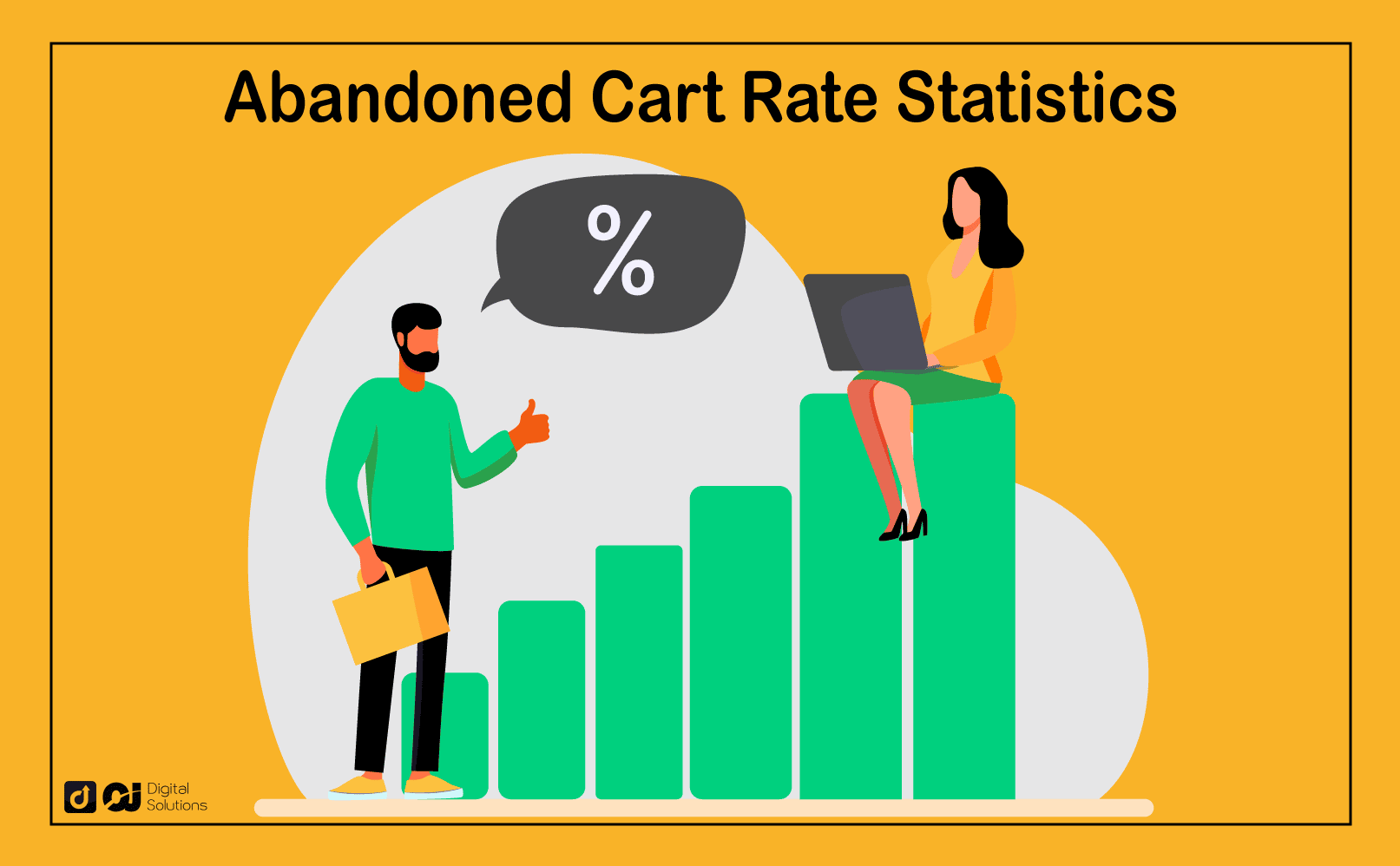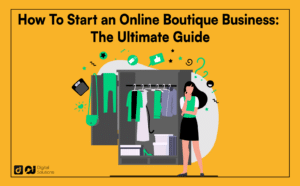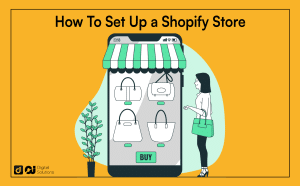Shopping cart abandonment is one of the biggest headaches of online sellers.
It can be incredibly frustrating to have a customer leave their cart right before the last few steps of the buying process.
How can you avoid a high abandoned cart rate, and retrieve the lost sales?
The first step is to arm yourself with authentic data and statistics that can help you make better business decisions.
If you have an uncomfortably high shopping cart abandonment rate, you’ve come to the right place.
My guide will explain the most critical statistics surrounding cart abandonment. I’ll also share tips to nudge your customers to complete their purchases.
Let’s begin.
What Is Abandoned Cart Rate?
Abandonment cart rate is the percentage of online shoppers who add items to the cart only to leave them.
To compute the rate of shopping cart abandonment, follow this formula:

Say you have 100 created online shopping carts but only 80 completed orders.
Following the formula, the shopping cart abandonment rate is 1 – 80/100 or 20/100. This equates to 20%.
The ideal rate of shopping cart abandonment should only be 20%. The lower the average cart abandonment rate, the more completed orders you’ll see.
However, this depends on the types of online shoppers the business targets and the nature of the business.
Cart abandonment is a common practice in most eCommerce stores. Because of this, online retailers factor in cart abandonment statistics when making decisions.
General Cart Abandonment Statistics
Here are some of the most popular shopping cart abandonment statistics:
1. The Industry-Wide Average Cart Abandonment Rate is 68.7%.
Cart abandonment is common across the ecommerce industry. Recent data shows that the average rate is just below 70%.
That means roughly seven out of every 10 shoppers won’t complete their purchase.
A high cart abandonment rate points to a need to improve aspects of your business, such as the checkout flow, shipping costs, or the online store design itself.
2. Mobile Users Have the Highest Abandonment Rate of 85.65%.
Mobile users have a high cart abandonment rate because some stores aren’t optimized for mobile.
Customers are likely to leave if your mobile site has a slow checkout page or a complicated process.
Optimizing your ecommerce store for mobile users involves increasing mobile speed and including only essential information on the page.
3. Ecommerce Brands Lose $18B per Year in Sales Revenue Due to Cart Abandonment.
A high rate of abandoned shopping carts affects eCommerce sales.
And with ecommerce brands losing $18 billion in annual sales revenue due to this, it’s an issue that companies need to address.
When too many potential customers abandon their purchase, you won’t be able to recoup your business costs, such as advertising and other acquisition costs.
Consumer behavior is not something you can change. Instead, you can improve your store with a better checkout flow and other additions.
4. Checkout Flow Optimization Improves Conversion Rate by 35.62%.
The most critical part of shopping online is online checkout. This is when shoppers either abandon their carts or become paying customers.
A complicated checkout process leaves potential customers frustrated, leading to a higher online shopping cart abandonment.
The checkout flow optimization (including checkout pages) has a significant effect on urging buyers to push through. It removes slight inconveniences and resolves clunky practices that add friction.
5. Extra or High Costs Are the Top Reason for Abandonment.
High or extra costs are the number one reason for abandoned carts.
Customer feedback says the top reasons are high shipping costs, additional expenses, or unclear prices.
You can offer free shipping or a discount code to make the price more attractive. Discount codes are also an excellent way to combat cart abandonment.
They make the customer feel like they gain more by purchasing the product.
6. 57% of Customers Ditch the Purchase If The Loading Period is Three Seconds or More.
Aside from the checkout process, site speed also matters. Website uptime directly affects the buyer’s decision.
Shoppers tend to abandon e-commerce sites if the website takes more than three seconds to load.
Imagine how much money ecommerce stores lose just because of site speed.
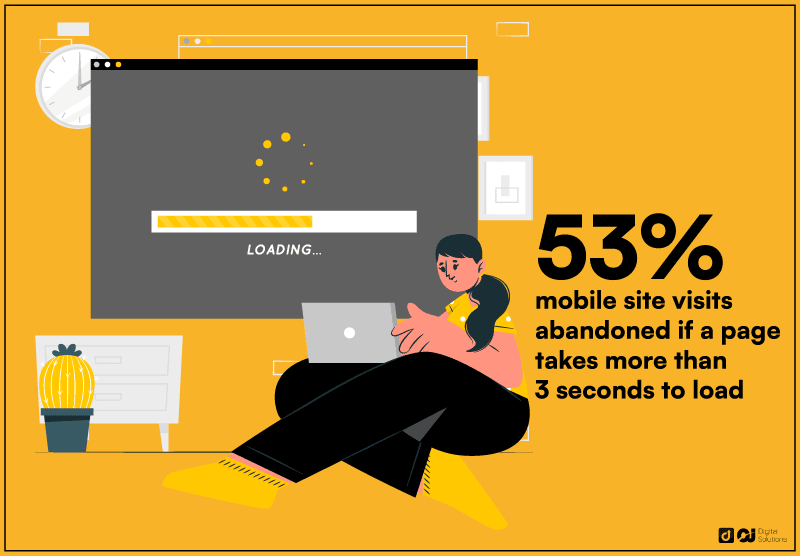
7. 55% of Customers Abandon the Purchase If They Have To Re-Enter Credit Card or Shipping Info.
Cart abandonment stats show that if customers have to enter your information twice, they will choose to leave their carts.
The ideal checkout flow should make the process as easy as possible. This will help the company avoid losing more than half its potential buyers.
8. 46% of Customers Ditch Orders if the Discount Card Fails To Work.
If you offer promo codes, coupon codes, or holiday sales, you should adhere to them. Most people buying online get frustrated when deals don’t work.
Deals make the buyer feel like making a purchase is a wise choice. If the deal fails, the buyer will have to rethink their decision.
9. Retargeted Ads Send 26% of Customers Back to the Site.
Just because someone’s initial window shopping session didn’t turn them into a customer doesn’t mean they will never be. Retargeted ads help increase the likelihood of making a sale.
The purpose of retargeted ads is to turn website visitors into customers. Since you’ve already spent on acquisition, spending a little more on retargeted ads will increase the chances of buyers.
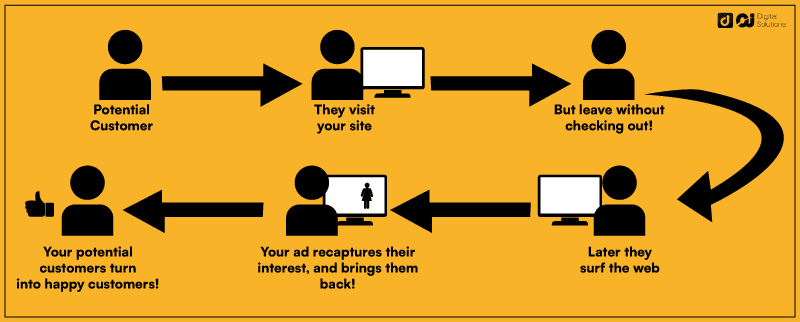
10. Facebook and Google Are the Best Platforms for Retargeting.
Retargeted ads aim to reach out to people who have already seen your product. People already familiar with your product sometimes have a higher chance of making a purchase.
The best platforms to launch them are Facebook and the Google display network.
This is because Facebook reaches 51%, and Google reaches 90% of all internet users.
Google Analytics will also help you gauge the effectiveness of your ads.
Average Shopping Cart Abandonment Rate
The average order abandonment rate for shopping carts differs on various devices.
Cart abandonment stats show a scale from desktop to mobile with the tablet in between.
Interestingly, the lowest abandonment is on the desktop, while the highest is on mobile.
- Desktop – 69.75%
- Tablet – 80.74%
- Mobile – 85.65%
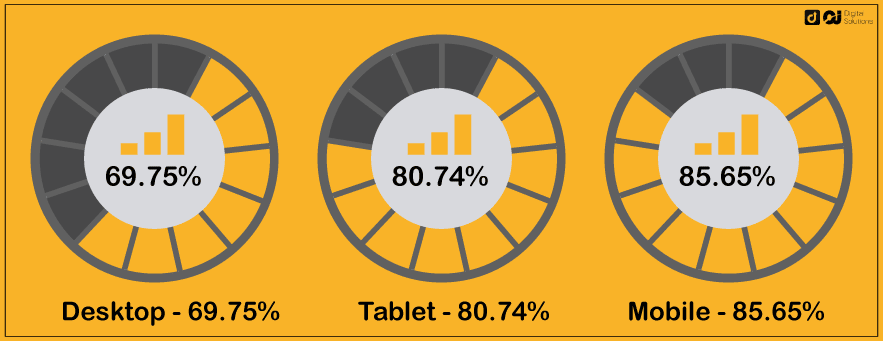
Most companies create their eCommerce store desktop first and mobile last. Because of this, the UI/UX of the store is the least optimized for mobile users.
Some businesses also make the mistake of making the mobile checkout design the same as the desktop design. The mobile shop pay method should be entirely different.
Improving the mobile shop pay method can improve your average checkout flow among all platforms.
That way, users who switch devices before making a purchase will have a seamless experience and push through with their purchase.
Effects of Shopping Cart Abandonment
So, what happens after customers leave their carts? Here’s what the data shows:
- 31% purchase from the same site at a later date
- 26% purchase from a different website
- 23% do not buy
- 8% purchase at a physical store
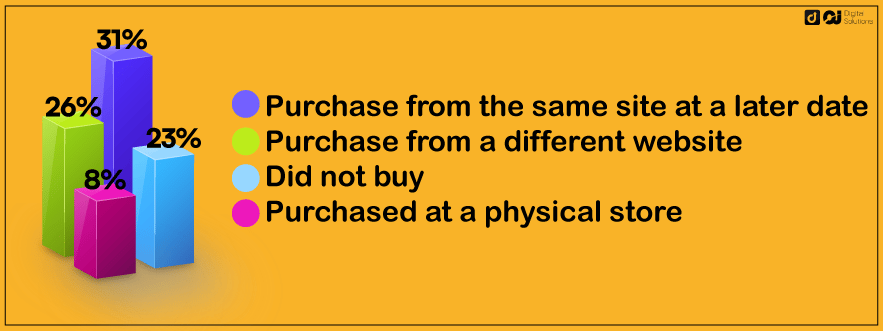
These cart abandonment stats show that even if a buyer abandons their cart, they still have a high chance of returning.
Businesses still have a good chance of winning the customer over. They can still improve their cart abandonment rate if they use retargeted ads.
Top Reasons for Cart Abandonments
Here are the ten main reasons why shoppers abandon their carts.
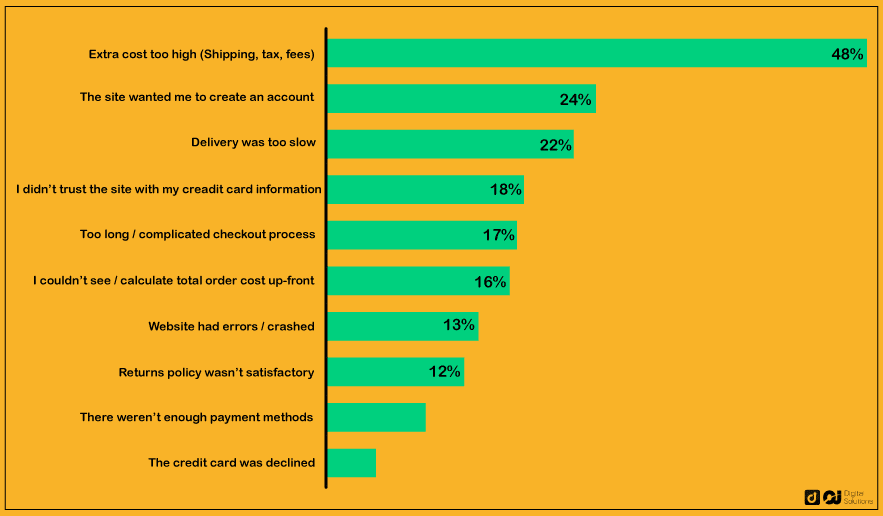
1. High Costs
48% of shoppers cite high extra costs as the most pressing reason for abandoning their carts. These costs typically include expensive shipping, additional tax charges, and other fees.
These customers are usually the hardest to win over.
People are willing to pay money depending on the value. The key is to make the product look like it’s worth its price.
2. Required Account
Mandatory account creation is another top reason for cart abandonment. 24% of potential buyers find it a nuisance to have to register to make a purchase.
A good solution is to offer guest checkout.
That way, you can still collect emails and other contact details for remarketing purposes without interrupting the checkout process.
3. Slow Delivery
As the graph shows, 22% of customers don’t push through with their purchases due to slow delivery.
That’s why picking a courier is very important. The sooner you deliver something, the higher the likelihood of an order.
For example, would you buy a $40 skateboard that ships next month or a $60 one that ships tomorrow?
In many cases, customers would choose the item with a faster shipping time, never mind if it’s a bit more expensive.
4. Site Is Not Trustworthy
Trust is a significant factor in cart abandonment.
According to Baymard Institute, 18% of shoppers leave because they can’t trust the site with their credit card information.
To improve trust, aim to create a professional-looking website. Add trust badges and social proof to show that your site is secure and trustworthy.
5. Long Checkouts
Statistics show that 17% of customers lose interest if the checkout process is slow or has too many steps.
The checkout process should be very straightforward. The more complicated it is, the greater the likelihood of losing potential customers.
6. Confusing Pricing
When stores don’t have the total cost of an item upfront, 16% of customers get confused and decide not to buy.
The key is to make the costs as direct and easy to understand as possible.
For instance, if you offer promos, place them on top of the original price and let the buyers see the difference.
If there are additional fees, make sure they reflect upon checkout.
7. Website Errors
13% of consumers cite website errors as a reason for leaving their carts.
A website error sends the message that the site cannot handle problems. It makes the customer feel like the site is not trustworthy.
Avoid this by using a reliable hosting, domain, or storage provider.
Whenever an error occurs, you should fix it as soon as possible to avoid negative backlash.
8. Weak Return Policy
Some businesses hide their returns policy, which causes problems for buyers post-purchase. Because of this, buyers have become more diligent.
It’s better to highlight the returns policies before customers purchase. This also acts as an additional assurance to buyers.
You can offer several options—refund, replacement, or store credits.
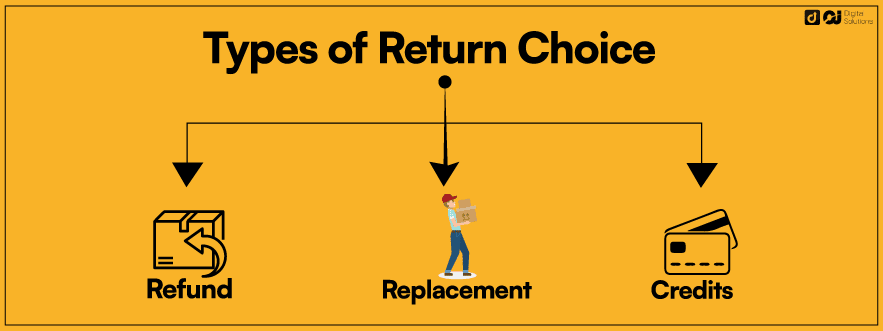
9. No Alternative Payment Methods
Some buyers push through with purchases only if their preferred payment method is available.
Businesses should offer options for buyers to pay through digital wallets and other payment methods. These include Google Pay and Apple Pay.
If a website offers various payment options, this reduces friction.
Less friction creates a smoother buying process, which can result in higher success rates.
10. Declined Card
A declined card can be the website’s or the customer’s fault.
It may be due to a glitch on the website’s end or an error on the customer’s end.
Either way, it’s best to offer as many payment alternatives as possible. This shows customers that there are other avenues to purchase the item they want.
Best Ways To Avoid Cart Abandonment
Here are some solutions for a high rate of cart abandonment.
Invest in a Trustworthy Platform.
To succeed in eCommerce, you must invest in a trustworthy platform. Examples of reliable platforms include Amazon and Etsy.
Although margins might be steep, customers are more likely to trust you on that platform. If you use a lesser-known platform, it can be hard to gain consumer trust.
It’s also vital that your website has a professional-looking design.
Aside from its appearance, it should also have the speed, features, and UI/UX of a professional store.
Be Open to Alternative Payment Options.
Limited payment options can cause a lot of friction. Being open to as many payment methods as possible increases the likelihood of a purchase.
For example, suppose the buyer has money on his PayPal. However, your store only accepts Apple Pay. This will create a lot of friction since the buyer still has to transfer funds to their Apple Pay account.
When you offer direct payment methods, buyers don’t have to jump through many hoops. They can check out before they have time to change their minds.
Offer Free or Discounted Delivery.
Buyers need to feel that they are on the winning end. This means offering limited deals or discounts to make them feel like they are saving money with their purchase.
For example, you can offer free or discounted shipping. This way, you can eliminate concerns about additional shipping costs.
The only decision that the buyer should be thinking of is whether or not to buy your product. Additional decisions tend to decrease the likelihood of the buyer making a purchase.
Create Better Perceived Pricing.
Intelligent pricing techniques help you make a product seem less expensive. It conveys the perception that your product has tremendous value.
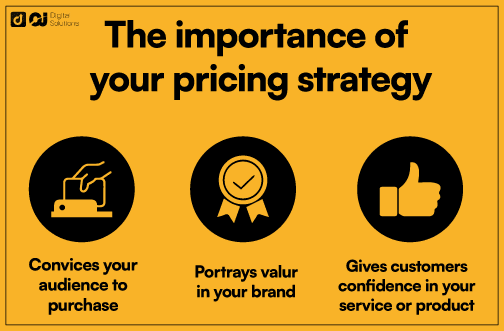
A common trick is to price a product at $99.99 instead of a full $100.
Another technique is to have customers see an expensive product first. After that, suggest cheaper products immediately.
This makes the cheaper products look way less expensive.
There are also other pricing techniques that you can use, such as product bundling or selling your goods at a slightly lower price than your competitors.
You can play around with pricing to figure out which ones give you the best margins.
Highlight a Returns Policy.
Some buyers are very cautious about making purchases. They tend to ask, “What if something goes wrong?”
To ease the doubt, highlight your returns policy. This helps reduce the buyers’ fear and works as a technique to inspire confidence.
The good thing about this policy is that it’s rarely needed for good products. Sometimes it’s just a way for businesses to gain trust.
Once a business gains customers’ trust, they become more comfortable spending larger amounts and making repeat purchases.
Retarget Customers.
Just because a visitor doesn’t order doesn’t mean you can’t turn them into customers.
With retargeting efforts like limited deals, you can get them to come back to your store. This incentivizes the customer to push through with their purchase.
Retargeting ads can also be a way for you to pitch different products if the past ones weren’t as convincing.
Send Abandoned Cart Emails.
Abandoned cart emails help remind customers of their purchases. And just like with retargeted ads, this is also a way for you to introduce other products.
Abandoned cart emails give customers a little push or reminder to check out.
You can do this effectively by including a checkout button in the email. Once clicked, customers automatically make the purchase.
This reduces the need for additional steps and decision-making.
Optimize Checkout Practices.
The checkout practice should be as easy as 1, 2, 3.
If it takes the customer more than three steps to check out, this usually causes them to rethink their purchase.
The ideal process should be for them to open the cart, confirm the purchase, and confirm the payment.
Optimize your website by making your checkout button bigger. You can also position it where the customer only has to move their mouse a bit.
The Bottom Line
As you can see, your cart abandonment rate directly affects your profit margins.
Knowing the reasons behind it is essential so you can address the issues accordingly.
Hopefully, these statistics have shed light on why cart abandonment happens and what you can do about it.
If you want to know more about eCommerce, check out our guide on online shopping statistics.

